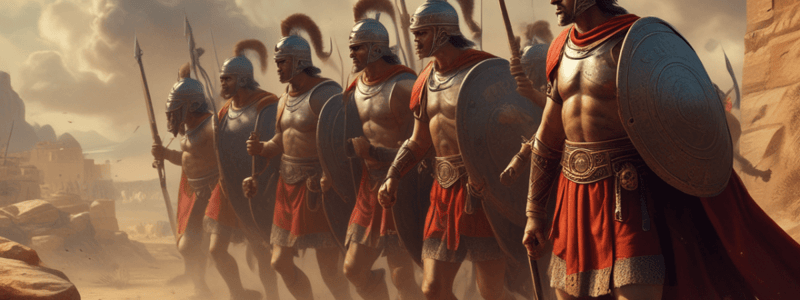Podcast
Questions and Answers
What was the primary reason for the clash between Rome and Carthage in the 3rd century BC?
What was the primary reason for the clash between Rome and Carthage in the 3rd century BC?
- Control of Sicily, a strategic and fertile land (correct)
- Securing of prosperous colonies
- Expansion of trade networks
- Control of the Mediterranean Sea
Who initially seized the Sicilian city of Messana in 264 BC?
Who initially seized the Sicilian city of Messana in 264 BC?
- Carthaginian forces
- Sicilian rebels
- Rome's disciplined military
- Italian mercenaries (correct)
What was the outcome of the first Punic War?
What was the outcome of the first Punic War?
- Rome emerged victorious, and Carthage was forced to surrender (correct)
- Rome emerged victorious, but at a great cost
- Rome was defeated, and Carthage emerged victorious
- The war ended in a stalemate
What was the 'corvus' used for in naval battles?
What was the 'corvus' used for in naval battles?
Where was the Carthaginian power situated?
Where was the Carthaginian power situated?
What was the outcome of the Battle of Agrigentum in 262 BC?
What was the outcome of the Battle of Agrigentum in 262 BC?
What was the outcome of the siege of Lilybaeum in the first Punic War?
What was the outcome of the siege of Lilybaeum in the first Punic War?
What was the main reason for Carthage's vulnerability after the first Punic War?
What was the main reason for Carthage's vulnerability after the first Punic War?
Why did Rome seize control of Sardinia and Corsica during the Mercenary War?
Why did Rome seize control of Sardinia and Corsica during the Mercenary War?
What was the main goal of General Hamilcar Barca in the Iberian Peninsula?
What was the main goal of General Hamilcar Barca in the Iberian Peninsula?
What was the immediate trigger of the Second Punic War?
What was the immediate trigger of the Second Punic War?
What was the result of the Battle of Cannae in 216 BC?
What was the result of the Battle of Cannae in 216 BC?
What was the strategy adopted by Rome after the Battle of Cannae?
What was the strategy adopted by Rome after the Battle of Cannae?
What was the outcome of the Battle of Zama in 202 BC?
What was the outcome of the Battle of Zama in 202 BC?
What was the result of the Third Punic War?
What was the result of the Third Punic War?
Why did Rome declare war on Carthage in 149 BC?
Why did Rome declare war on Carthage in 149 BC?
Flashcards are hidden until you start studying
Study Notes
• Over 2,000 years ago, the Punic Wars took place between Rome and Carthage, lasting over a century and changing the Mediterranean region and shaping the Western world.
• Rome, a burgeoning republic on the Italian Peninsula, was known for its disciplined military, ambitious leaders, and desire to secure and expand its territory.
• Carthage, situated in modern-day Tunisia, was a flourishing maritime power with extensive trade networks and prosperous colonies stretching across the Mediterranean.
• The two civilizations initially clashed over the control of Sicily, a strategic and fertile land, in the 3rd century BC, leading to the first Punic War.
• The first Punic War began in 264 BC, sparked by the seizure of the Sicilian city of Messana by Italian mercenaries, and ended in 241 BC with Rome emerging victorious.
• During the war, Rome initially suffered on the seas, but eventually built its own fleet and copied Carthaginian ship designs, leading to a series of naval battles.
• The Battle of Agrigentum in 262 BC was the first major land battle of the first Punic War, where Rome laid siege to the Carthaginian-held city and eventually forced the Carthaginians to flee.
• The subsequent naval battles of Mylae, Sulsis, and Ecnomus between 260-256 BC were grand spectacles of maritime warfare, where Rome's shipbuilders created a secret weapon called the corvus, a boarding bridge that turned sea battles into infantry battles.
• The culminating battle of the first Punic War was the siege of the Sicilian city of Lilybaeum, which occurred between 250-241 BC and ended with Rome's victory.
• The resulting peace treaty forced Carthage to surrender Sicily to Rome and pay a large monetary fine.
• The aftermath of the first Punic War left Carthage vulnerable, weakened, and facing a new crisis when unpaid mercenaries revolted, leading to the Mercenary War or the Truceless War.
• While Carthage was consumed with the Mercenary War, Rome seized the opportunity to seize control of the Carthaginian islands of Sardinia and Corsica, perceived by Carthage as a breach of the peace treaty and a hostile move.
• Carthage sought new sources of money to help rebuild its empire and sent General Hamilcar Barca to the Iberian Peninsula, where lots of silver could be found, to expand Carthaginian control and rebuild its military strength.
• This period saw the rise of Hannibal Barca, one of history's most iconic generals, who was raised with an intense hatred for Rome and was groomed to be a military leader.
• In 218 BC, rising tensions between Rome and Carthage ignited once again, leading to the Second Punic War, which featured one of the most audacious military campaigns in history.
• The immediate trigger of the Second Punic War was the siege of Saguntum, a city in Spain allied with Rome but in the sphere of Carthaginian influence, which was captured by Hannibal Barca.
• Hannibal decided to bring the war to Rome, marching his army from Spain through France and crossing the Italian Alps, suffering heavy losses but emerging as a united fighting force.
• The sudden arrival of Hannibal's army in Northern Italy took Rome by surprise, and they hastily sent their armies north to engage him at the Battle of Lake Trasimene in 217 BC, where Hannibal set an ambush and slaughtered the entire Roman army.
• Rome adopted the Fabian strategy, avoiding major battles and focusing on disrupting Hannibal's supply lines, but eventually sent out another army to snatch a quick victory against Hannibal, leading to the infamous battle of Cannae in 216 BC.
• Even in victory, Hannibal's strategic limitations emerged, as he couldn't seize the city of Rome itself and had to remain in Italy waiting for the Romans to surrender.
• One young Roman general, Scipio Africanus, who was lucky to have survived Cannae, studied Hannibal's tactics and decided to turn the tide of the war by taking the fight to Carthage's home territories in Africa.
• In 202 BC, the decisive battle of Zama marked the end of the Second Punic War, where Hannibal was defeated on the battlefield by Scipio, forcing Carthage to sue for peace.
• The terms of peace were harsher this time, with Carthage losing all its overseas territories, having its navy limited, and being prohibited from waging war without Rome's permission.
• The conclusion of the Second Punic War left Rome in a position of strength in the Mediterranean, while Carthage was reduced to a shadow of its former self.
• During this period, Rome further solidified its control over the Mediterranean, annexing territories and establishing its influence over kingdoms in the east.
• Carthage struggled to recover from the losses of the Second Punic War, but eventually managed to pay off its war indemnity and sought to restore some of its former prosperity.
• However, Carthage's recovery alarmed Rome, fearing a resurgence of their old rival, leading to a final confrontation in 150 BC when Carthage clashed with Numidia, a Roman ally in Northern Africa, over territorial disputes.
• The scene was set for a final confrontation, with Rome declaring war in 149 BC, leading to the Third Punic War, primarily a protracted siege of Carthage itself.
• Despite facing starvation and overwhelming odds, the Carthaginians resisted fiercely, displaying a resilience that surprised the Romans, but ultimately fell to the Roman general Scipio Aemilianus in 146 BC.
• The city of Carthage was set alight and burned for days, and its remaining walls were torn down, with the last survivors being sold into slavery.
• Carthage's last territories were taken by Rome and turned into the province of Africa, marking the end of Carthage as a power and Rome's rise as a genuine superpower in the ancient world.
Studying That Suits You
Use AI to generate personalized quizzes and flashcards to suit your learning preferences.





